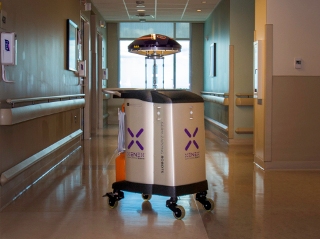Dec 23 2015
The latest droid with germ-blasting technology has arrived on the Treasure Coast! Martin Health System has taken a leap into the future by acquiring four Xenex Germ-Zapping Robots™.
 As hospitals look for new and innovative ways to battle the multi-drug resistant organisms that can cause hospital acquired infections (HAIs), Martin Health System has taken a leap into the future by acquiring four Xenex Germ-Zapping Robots(TM) to destroy pathogens that cause infections. (Photo: Business Wire)
As hospitals look for new and innovative ways to battle the multi-drug resistant organisms that can cause hospital acquired infections (HAIs), Martin Health System has taken a leap into the future by acquiring four Xenex Germ-Zapping Robots(TM) to destroy pathogens that cause infections. (Photo: Business Wire)
Hospitals across the nation and around the world are looking for new and innovative ways to battle deadly pathogens and kill multi-drug resistant organisms that cause hospital acquired infections (HAIs). This cutting-edge technology uses pulsed xenon ultraviolet (UV) light to quickly destroy bacteria, viruses, mold and other pathogens. The portable disinfection system is effective against even the most dangerous pathogens, including Clostridium difficile (C.diff), norovirus, influenza, Ebola and methicillin-resistant Staphylococcus aureus, better known as MRSA.
“One hospital acquired infection is too many,” said Michael Romano, MD, inpatient medical director with Martin Health Physician Group. “We are doing everything within our means to reduce the risk of infection and believe these robots will play a significant role.”
The Xenex Full-Spectrum™ UV room disinfection system works by pulsing xenon, an inert gas, at a high intensity in a xenon ultraviolet flashlamp. This produces intense ultraviolet C (UVC) light which penetrates the cell walls of microorganisms, including bacteria, viruses, mold, fungus and spores. Their DNA is fused, rendering them unable to reproduce or mutate, effectively killing them on surfaces without contact or chemicals.
The portable system can be used in any department and in any unit within a healthcare facility, reaching hard-to-kill bugs in hard-to-reach places. A robot can disinfect a typical patient or procedure room in five minute cycles without warm-up or cool-down times.
Once standard cleaning procedures are completed by an environmental services associate, the Xenex robot is wheeled into the room and set for its automated sequence. The associate leaves the room, placing a sign outside warning people not to enter while the robot is in operation. A motion sensor on the robot automatically shuts off the machine if anyone should enter by accident.
As the four Xenex robots become integrated into Martin Health’s hospital cleaning operations, they have been affectionately given names voted on by Martin Health associates.
“Martin Health has made a substantial investment in this latest infection control technology,” Romano said. “It underscores our commitment to patient care and the community we serve.”
The Xenex system has been credited by health care facilities across the U.S. for helping them reduce their infection rates significantly. More than 300 hospitals, Veterans Affairs and Department of Defense facilities in the U.S., Canada, Africa and Europe are using Xenex robots, which are also in use in skilled nursing facilities, ambulatory surgery centers and long term acute care facilities.